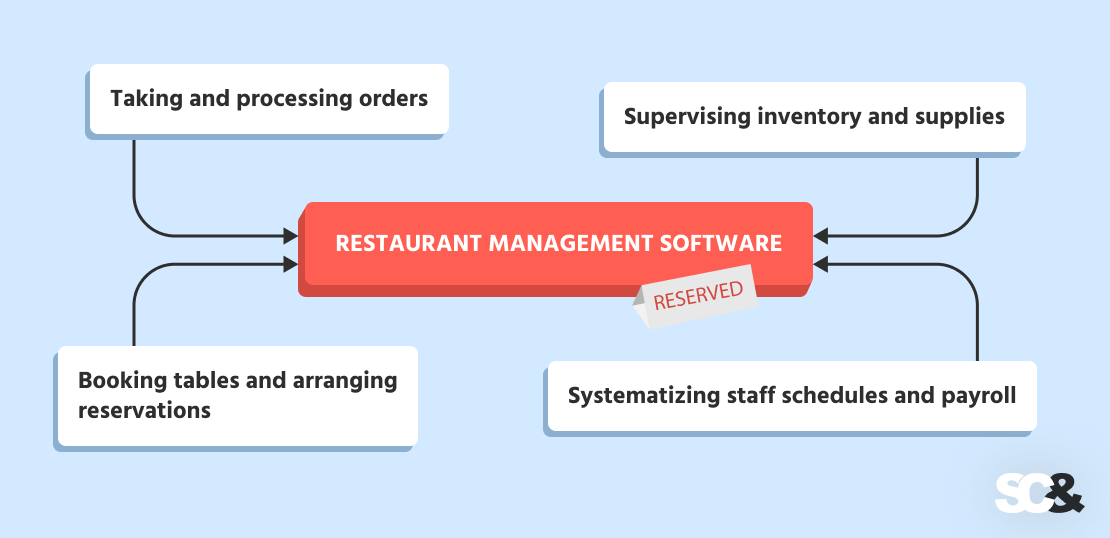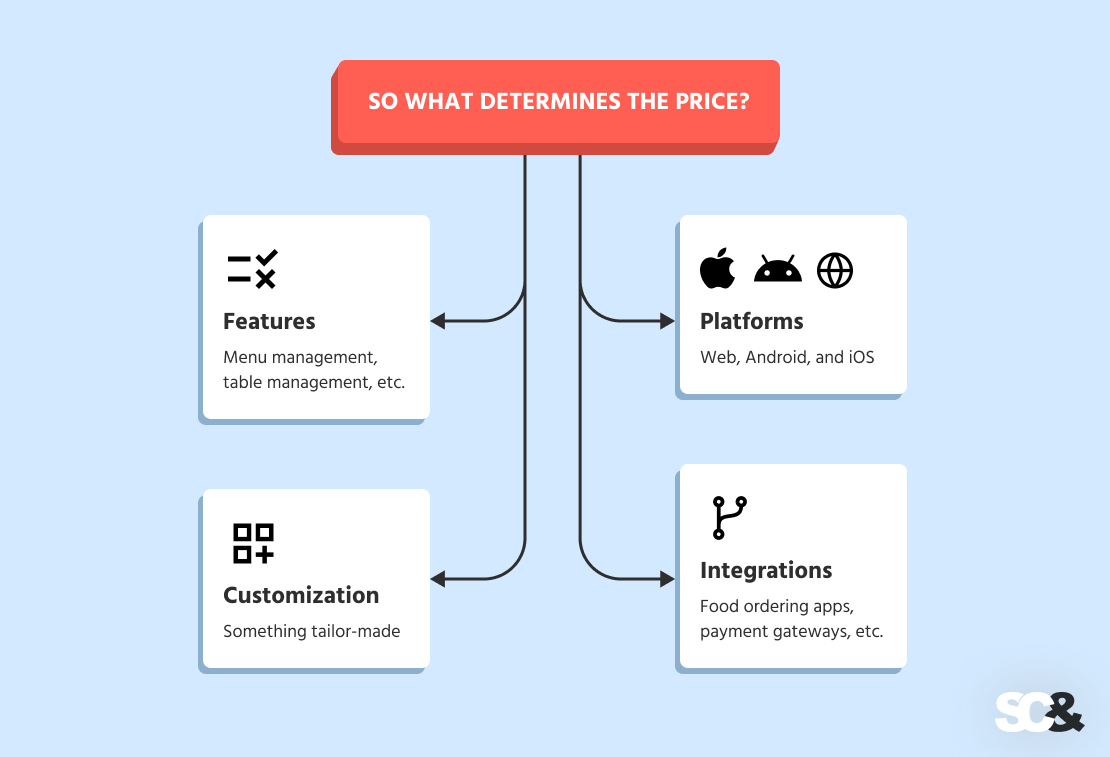How to Build Restaurant Management Software: A Complete Development Guide for 2025
Have you ever noticed that the restaurant industry has evolved a lot over the last couple of decades or so with the use of digital technology?
For example, combined food services and drinking places due to technologies developed by the US alone generated a staggering $1.09 trillion in revenues in 2023 supporting 13.2 million jobs.
It should be noted, however, that digitalization is taking place not just online, but also in restaurants themselves. Most restaurateurs try to adopt at least simple tech inventions in the hope of future monetization and fulfillment of modern-day restaurant requirements.
If you are also thinking about how to technologically revamp your restaurant business, we would recommend starting with restaurant management software.
What Is Restaurant Management Software?
Restaurant management software is a type of software solution that helps managers and restaurant owners carry out daily tasks: taking and processing orders, supervising inventory and supplies, booking tables and arranging reservations, systematizing staff schedules and payroll, and so on.
Instead of using notebooks, spreadsheets, or different systems for each task, restaurant management software does it all in a single system.

What Are the Types of Restaurant Management Software?
Not all restaurants are the same and neither is the software they apply. Restaurant management solutions come in different forms based on the conditions of different restaurants, as well as their models and sizes.
1. Full-Service Restaurant Software
This type is made for sit-down restaurants with table service. It assists with reservations, order taking, kitchen coordination, billing, and employee scheduling.
For whom: Traditional dine-in restaurants, fine dining, family-style restaurants.
2. Quick Service Restaurant (QSR) Software
Best suited for food trucks, cafes, or fast food restaurants, this software is made for those who seek speed. It helps put up with speedy ordering, quick payments, and high traffic. Some also support self-service kiosks or mobile orders.
For whom: Fast food spots, cafes, food trucks, food delivery services, casual eateries.
3. Cloud Kitchen Software
This software is developed for delivery kitchen restaurants (also known as ghost kitchens). It helps run online orders, delivery apps, virtual menus, and kitchen management, with no dining space required.
For whom: Cloud kitchens, ghost kitchens, virtual restaurant brands.
4. Franchise and Multi-Location Software
Made for franchises or chain restaurants, this type enables managers to operate multiple locations from one site. It can manage menus, regulate prices, optimize inventory, and control staff at all locations.
For whom: Restaurant chains, franchises, businesses with multiple locations.
5. POS-Only Software
This is a simpler version used specifically for payment processing and ordering. It is suitable for small businesses with some other programs already installed for managing employees or inventory.
For whom: Small restaurants, kiosks, or businesses that only need basic sales functionality.
Why You Should Invest in Restaurant Management Software
Restaurant operation is a matter of juggling many operations at once. With the wrong tools (or the absence of anything at all), it’s easy to do it wrong and waste precious time on manual entry. That’s why investing in a restaurant management system can pay off.

First of all, restaurant software can automate a range of chores, such as processing orders, updating the restaurant inventory, monitoring shifts, and processing payments. Restaurant staff, in turn, can dedicate spare time to personalize customer experience and not paperwork.
Another benefit is related to live reports and analytics. Having all of the sales data, employees, and customers in one place allows managers to make adequate decisions and increase customer satisfaction. They can keep track of stock, reduce food waste, avoid over-ordering, and have better portion control.
Lastly, it is simpler to control staff performance and labor costs with professional software. You can watch working hours, organize shifts, and determine ways to diminish burnout.
And most importantly, you can experiment with different monetization models and strategies to ensure profitability without compromising service quality.
Key Features to Include in Custom Restaurant Management Software
According to GrandViewResearch, the restaurant management software market is expected to grow immensely from 2025 to 2030. What does this mean? It means that your competitors are not standing still and are also doing everything possible to attract more customers.
Therefore, it is important to include such functionality that would allow you to always be one step ahead and perform the same operations faster and more correctly.
1. Point of Sale (POS) Integration
Good restaurant POS software helps process orders, collect payments from different devices, such as computers, tablets, or handhelds, and enables customers to split the bill and leave tips as they see fit.
2. Supply Chain & Inventory Management Software
The supply chain & inventory management module permits managers to see all ingredients and supplies in real time. It automatically updates stock whenever things are used or received, connects with suppliers if necessary, or alerts when items are low or run out.
3. Order and Menu Management System
Wherever your customers eat in, pick up, or get delivered, your software should be capable of handling all these order types. Order management allows for integration with online ordering websites, showing chefs new orders as they come in so orders are not mixed up, and viewing past orders to allow customers to order the same meals again.
4. Reservation & Table Booking
This feature helps more rationally manage seating arrangements by showing which tables are free in real time. It can have a waiting list when you are full and sync with your calendar so kitchen staff know when to expect guests.
5. Management of Staff & Payroll
Staff and payroll management is a time-saving feature that enables managers to create shifts from the point they need staff. It also tracks when employees clock in and out for accurate payroll processing.
6. Analytics & Reporting Tools
Overall, analytics offers valuable insights on sales, customer, and staff performance. It keeps you up to date on what is working and what’s not and generates convenient dashboards to view aspects that need improvement.
Cost of Restaurant Software Development
The cost of creating a restaurant management system can be very different based on how much you need. If you’re building a simple system with few features, it will cost less than a full-fledged solution with lots of advanced tools.
Even though it can be a costly undertaking, the right software can save you time, reduce mistakes, and make your restaurant more effective.
So what determines the price?
- Features you include: The more features such as menu management, table management, or loyalty programs, the more development time.
- Customization: If you want something tailor-made to streamline your restaurant, it is going to cost more than using a generic design.
- Platforms supported: Web, Android, and iOS development separately raise the cost.
- Integrations: Having your program integrated with food ordering apps, payment gateways, or accounting systems takes extra work.
- Development location: North American companies tend to be more expensive than those based in Eastern Europe or Asia.

Rough cost estimates:
- MVP (minimalistic version): $25,000 – $50,000
Essential features like a POS system, low-order handling, and easy inventory level management need to be part of it.
- Full custom system: $70,000 – $150,000+
Has advanced features like CRM, analytics, mobile apps, third-party integrations, and multi-branch management.
Don’t also forget about recurring costs after the software has been released. These can include:
- Maintenance and bug fixes
- Implementing new features or improvements
- Cloud hosting and data storage
- Support and maintenance
For simplicity’s sake, the majority of restaurants start out with a minimum viable product (MVP) and add more features incrementally over time.
Hiring an experienced company for custom software development services can also assist you in determining what you need most, avoid costly mistakes, and have a system that matches your business.
How to Build Restaurant Management Software: Most Appropriate Options
Creating a restaurant management system is a complex task that goes way beyond the mere creation of an app. It requires having a comprehensive understanding of the dynamics of restaurants and market trends, careful planning of features, simple design, flawless integrations with hardware and third-party services, and upkeep.
For most restaurant owners, this is a hassle, time-consuming, and costly to do in-house.
Hence, it is generally better to hire a professional software development company. A mature development team will guide you through every step, from researching user needs and designing the interface to coding, testing, and deploying the software on devices.
They’ll also handle POS integration, staff training, and ongoing support. With experts assisting you, you get a solution adjusted to your restaurant’s unique needs, scales with your business, and allows you to get more things done from day one.
Why Choose SCAND for Software Development Services?
Picking the proper app development partner is just as important as picking the correct features for your restaurant software. We at SCAND possess over 20 years of history in building solid, custom software solutions for businesses worldwide, including the hospitality and restaurant industry.
Our team of skilled developers, UI/UX designers, and QA engineers works with you to learn your unique goals, business needs, processes, and pain points.
Whether you’d like to develop a full restaurant management system from scratch or upgrade the tools you already have, we offer full-cycle development services, from concept and design to software testing and further maintenance.
If you feel ready to dive into restaurant management software development, get in touch with us today to schedule a free consultation or request a project quotation.












